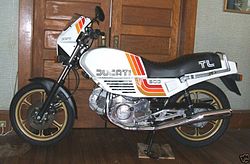- Ducati Pantah
-
Ducati Pantah Manufacturer Ducati Production 1980-1986 Successor SuperSport Class Sportbike Engine 90° V-twin The Pantah was the first of the belt-driven camshaft Ducati motors, the first generation of the current Ducati V twins. First shown December 1979, it came on the market as the 1980 500SL and the last of the line 650SL was sold in 1986. Successful in racing as the 600 cc TT2 and later TT1 750 cc racer, it was a lighter, shorter wheelbase motorcycle, in a new trellis frame that was to become a trademark Ducati feature.
Contents
Pantah 500 cc
When the 1976 350 cc and 500 cc vertical twins were recognised as a marketing disaster, Fabio Taglioni went to work developing the Pantah.
The Pantah 500 is where the current line of V twins began. Developed from the last of the GP500 racers of 1973, the Pantah and its successors have shown that, contrary to the previously accepted wisdom, a twin can race against the fours and win.
The bike was first shown at the Milan Bike Show in December 1979. The prototype was different again to Ducati’s earlier bikes: it had a trellis frame, with the suspended motor acting as a stressed member, the swingarm pivoted on the rear of the crankcase, the SOHC was driven by toothed rubber belt, the primary transmission was via Morse chain and the front disc was a Campagnolo Hydroconico.[1] The claimed performance was impressive: 500 cc, 50 hp (36.5 kW) @ 8500 rpm, 180 kg, 1450 mm of wheelbase, significantly different from the earlier bevel head V twins which were long bulky and stable, and easily surpassed the ill-conceived 1976 parallel twins.
The Pantah came onto the market in 1980 as the red and silver 500SL, with the engine using belt driven camshafts, and a plain bearing crankshaft. It had the same bore and stroke as the old 500 racer, 74 mm x 58 mm, but the head had a 60 degree included valve angle and kept the belt driven camshafts used on the final 500GP engine version. They were noticeably lacking in bottom end and mid range torque, but revved freely enough. The suspension seemed less certain than earlier Ducati models, and the 35 mm front forks lacked rigidity.
Enthusiasts found the final gearing too tall, and the intake and exhaust restrictive. If you changed those for higher flow items, and lowered the gearing, it gave a performance increase.
Pantah 600SL, 600TL and TT2 racer
In 1981 the silver 600SL became available with fairing and hydraulic clutch activation. It had an 80 mm bore and the 58 mm stroke giving 583 cc (The first Pantah based racer,[2] the 600 cc TT2 racer used 81 mm) By 1984 the last of the 600SL bikes had MHR paint.
In 1982 the 600TL was released, and the styling was promptly panned. The TL only lasted till 1983.
Many suspect that Suzuki named their revolutionary TL1000S 90-degree v-twin after the Ducati TL.
Pantah 650SL and TT1 750 racer
In 1983 the 650SL came about because of the need to homologate the TT1 750 racer’s 61.5 mm stroke. Instead of producing a production 750, the 650SL was born with 82 mm bore and the required 61.5 mm stroke. bodywork is virtually identical to the 600 but was painted red and yellow, had a different instrument layout and some other minor changes, but it had more torque, and that was a big improvement and was considered by many as THE pantah. The 650SL produced 63 hp at 8,500 rpm.
Cagiva takeover
Cagiva SpA (from CAstiglioni GIovanni VArese) took over Ducati Meccanica in 1985. Ducati engines promptly appeared in Cagiva-badged motorcycles.
The 650SL continued to be produced after the Cagiva take-over, and ended production in 1986. The Cagiva Alazzurra was a redesigned Ducati Pantah.[3]
For the full history of the ensuing Pantah based motors see Ducati Air-cooled V Twins (1970 on).
References
- ^ "The Pantah SL". Pantaheads.com. http://www.pantaheads.com/index_file/page0015.htm. Retrieved 2007-01-08.
- ^ "History". Ducatisuite.com. http://www.ducatisuite.com/history.html. Retrieved 2007-01-08.
- ^ Richard Backus (January/February 2008). "The Cagiva Alazzurra". Motorcycle Classics. http://www.motorcycleclassics.com/classic-italian-motorcycles/cagiva-alazzurra.aspx. Retrieved 2011-10-04.
Ducati Current motorcycles: 848 · 1198 · 1199 · Diavel · Hypermotard · Monster (696 · 796 · 1100) · Multistrada 1200 · StreetfighterPrevious motorcycles: 60, 60S, 65S · 65T, 65TL, 65TS · 98, 98N, 98T, 98TL, 98S, 98SS · 98TS and 85, 98, 125 Bronco · 125 Aurea · 125 T, TV · Apollo · Mach 1 · 750 GT · 900GTS · Pantah · Paso · 851 · 888 · SuperSport · 916 · 748 · 996 · 998 · 800SS · 749 · 999 · 1098 · Desmosedici RR · ST series · SportClassicDucati mopeds: Other products: Sogno (camera)Designers Ducati Corse racing Categories:- Ducati motorcycles
Wikimedia Foundation. 2010.

